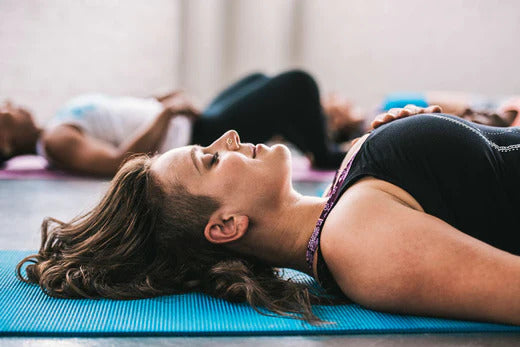Off the Couch and Onto the Mat: What to Expect from Your First Yoga Class
Posted on June 28 2023

by: Kimberly Fowler
Inspired to try your first yoga class but have no idea what to expect? Get tips on how to approach your first class in this excerpt from Kimberly Fowler's yoga for beginners book The No OM Zone: A No-Chanting, No-Granola, No-Sanskrit Practical Guide to Yoga. Find out what to wear, when to arrive, basic poses you should know, and more.
Yoga clothes
I constantly get emails from people asking me, "Kimberly, what do I wear to a yoga class?" Practically speaking, it will depend on what type of class you are going to. If you are going to a power yoga class or a Bikram (hot) yoga class, you are going to sweat, so you would want to wear clothes that wick away sweat (similar to what you would wear to go running).
Baggy T-shirts are fine for guys, but women should wear a tight-fitting top so that when you are in an inversion (like Downward Dog), your top doesn't come down over your head. I often see women trying to pull their tops up in Shoulder Stand because they don't want their stomachs showing — this can be dangerous.
Wear quick-dry capri or full-length fitted pants; this will help your instructor check your alignment.
Yoga gear
If you are new to yoga and haven't bought a mat yet, call ahead and ask if the yoga studio or gym has a mat for you to borrow or rent for the day. I suggest buying your own mat after you have tried a few yoga classes. Yoga mats come in all kinds of colors and materials, from natural rubber to synthetic, as well as different levels of thickness. Use a sponge to wash your mat with soap and water, and let it air-dry.
Most studios provide basic props, such as blocks, which are used to help with alignment, and straps, which can help if you are new to yoga. You also want to bring some water and a towel.
Yoga etiquette
Get there early: Arrive at least ten minutes before your first yoga class to get a spot where you feel most comfortable. If you are going to a class that is popular (because of the teacher or the time of day), try to get there 15 to 20 minutes ahead of time. I have students who come to my weekend class a half-hour early to get their spot; they bring the newspaper and read it before class starts.
After you arrive: Take off your shoes and socks before you walk into the room; sometimes studios have cubbies for your shoes, right inside the yoga room. If you are not sure, ask the front desk or just watch what everyone else is doing. I suggest finding a place in the back by the door — you will be able to see and follow the people in front of you. Whether you borrow a mat from the studio or bring your own, make sure you unroll it facing the instructor. I had a student once who came in, placed her mat next to mine, and faced the other students in the class. If you notice that everyone is facing you, you might want to turn around!
Communicate: Before class starts, introduce yourself to the instructor. Tell the instructor whether you have any injuries, especially a recent one, so he or she can give you modifications.
Breathe: It's common for new students to hold their breath during yoga poses they find challenging. Breathing deeply can help you relax. In the beginning, don't worry about matching the instructor's breathing instructions exactly; just don't hold your breath.
Practice your basic poses at home: Students at my studios always practice at home. I have a lot of type A personalities, and they want to really “nail the pose.” If you practice some of the basic poses at home, such as Downward Dog, Upward Dog, Warrior 1 and Warrior 2, which are part of any beginner yoga class, you will feel more comfortable when you do come to class.
Don't leave in the middle of Corpse pose: Most yoga classes end with Corpse pose, also called Savasana (pronounced sha-VASS-ahnah). With this pose, you lie flat on your back, close your eyes, and relax. You never want to walk out of a class when they are in Corpse pose. If you have to leave, do it before.
Namaste: Don't be scared off when your instructor bows her head as if in prayer, clasps her hands together in front of her heart and says, "Namaste" (pronounced nah-mas-TAY). You'll notice the class says it back as well. This Sanskrit word means "I honor you" and is normally said at the end of class.